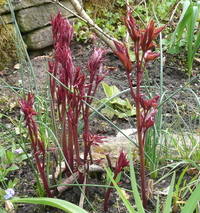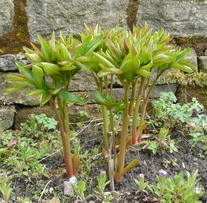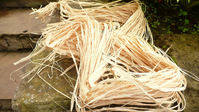A stake in time
Posted on
 Many garden plants, especially the herbaceous perennials need staking and its a job I often leave until it's almost too late; now is a good time to look plants and consider staking.
Many garden plants, especially the herbaceous perennials need staking and its a job I often leave until it's almost too late; now is a good time to look plants and consider staking.
Looking at photo one, this Peony is ready to for the support to be put in place, before it grows on too much, photo two shows a Peony which has grown almost, but not quite, too far. As photo three shows it was just possible to squeeze plant and foliage through the support without damaging the buds, but it was a delicate exercise which could easily have damaged the flower buds.
Some plants especially the taller ones, particularly those whose flower heads can become heavy with rain such as Delphiniums and Hollyhocks, will need staking to keep them upright. Others such as Peonies, Hemerocallis, Nepeta to prevent them flopping over. It can  be tempting, when looking at Hemerocallis, with good strong new growth to think it will be alright on its own; but as summer wears on the weight of the flowers and the leaves, will push the plant down which will suffocate anything around it and flatten it out. Peony and Dahlias are best staked to support the flower heads as the size and weigh of the flowers can seem too much for the stems without some support. The stakes can look intrusive when first placed, as in the Peony photograph, but the plant will soon grow over them.
be tempting, when looking at Hemerocallis, with good strong new growth to think it will be alright on its own; but as summer wears on the weight of the flowers and the leaves, will push the plant down which will suffocate anything around it and flatten it out. Peony and Dahlias are best staked to support the flower heads as the size and weigh of the flowers can seem too much for the stems without some support. The stakes can look intrusive when first placed, as in the Peony photograph, but the plant will soon grow over them.
For Delphiniums and tall plants I think the spiral supports are best, and placed just as the flower stalk appear so as to tease it to grow through the circles which will keep it well supported. Delphiniums, glorious plants but they do suffer badly when it rains s the flower heads become very heavy which can cause the stems to snap.
Hemerocallis are best supported with a large semi circle stake to lift the foliage and hold it more upright.
For other plants rings and linked stakes will support well, and I also save and use woody cuttings to try and make the staking as natural as possible.
How you tie into the stake is important as the plant needs to flex with the wind and not be cut by the tie. I think raffia makes really good soft, but strong ties, looks attractive and degrades down if necessary. Tie loosely with a figure of 8 knot so that the support and plant can move.With some other perennials, such as Nepeta, Sedums, phlox you can use the "Chelsea Chop" which has the effect of reducing the size of the plant, making it bush and flower a bit later but as the plant is sturdier it is less likely to flop and need staking. For more about the Chelsea Chop follow the link
soft, but strong ties, looks attractive and degrades down if necessary. Tie loosely with a figure of 8 knot so that the support and plant can move.With some other perennials, such as Nepeta, Sedums, phlox you can use the "Chelsea Chop" which has the effect of reducing the size of the plant, making it bush and flower a bit later but as the plant is sturdier it is less likely to flop and need staking. For more about the Chelsea Chop follow the link

Add a comment: